
Ancient Cultic Associations
of Saffron Crocus
Part II:
The Saffron Mother
The Saffron-goddess had a substantially greater role in Crete than in later antiquity. In Greece & Rome she came to be identified as Eos or Aurora the Goddess of the Dawn, with herself, her throne, her sacred robes, even her wedding bed, all the color of gold & saffron.Dawn-goddesses were frequently warlike, arising each morning to battle with things of the Night such as Eos single-handedly chased out of the sky. Ovid among others called Eos the "Saffron mother," & many ancient poets allude to her rosy-red (saffron-dyed) fingers. She arrived on the earth each morning in a war-chariot drawn by bright roan horses. The Dionysiaca calls her "Farshooting Eos" since she is a mistress of archery.
In Hesiod's Theogony she is the "All Seeing," indicating she was once a Sun-mother like All-seeing Shapash in the lands of the Patriarchs. Because Greeks perceived the sun as a male principle only, the plethora of Sun-mothers coopted from other cultures were transformed into Dawn-goddesses or Moon-goddesses. Such names as alluded to the Sun as "Bright" or "Shining" need not be altered in order to revamp them as Moon-goddesses. For example, the Greek goddess Leto, allegedly a Moon-goddess, is actually the same as the Arabic Sun-mother Allatu, which is how it came about that even in the Greek reassessment of Leto's significance, she remained the mother of Sun (Apollo) & of Moon (Artemis). Dawn-goddesses however had features of the All Mother so deeply ingrained in them, they had to be placed at the cusp of night & morning because they once had rule over both Life & Death, Light & Dark, Wellness & Disease, & were less easily demoted to the role of Moon-goddess only.
The Odyssey notes that Eos's golden robe was an embroidered "flowery cloth" & The Iliad says she lays her saffron robes upon the earth, a protective action. The Iliad as well notes that She was the source not only of the enlightenment of "Zeus & the other immortals" but also of men. Thus even Olympus would dwell in ignorance & darkness without Eos or Aurora, she that was the messenger of Titans, especially of her father Helios. She seems herself to be more of a Titan than an Olympian, originating as she does from an earlier level of myth associated with Minoan culture
There is a mystical attachment to Saffron Eos who harmonizes Fire & Water, being as she is both Light & Dew, dwelling in a world that Night readied for Day. This harmony is at the base of many mystical systems of religion. The myths of of Eos falling in love with such mortals as Kephalos, Orion, Kleitos & Tithonos preserves an echo of this ancient idea that Eos is the source of mortal enlightenment. She was simultaneousy a Goddess of erotic love, & was said to spend her nights with a series of mortal lovers, her saffron being a mighty aphrodisiac.
That she was the kidnapper of such lovers as Tithonos & Kephalos, rather than their seducer, reveals an aggressiveness like unto that of Zeus who raped women in sundry guises without bothering to win them with his charms. When Zeus tricked Europa the mother of Minoa into coupling, he first took the form of a gentle bull & breathed saffron spice from his nostrils. Just like Zeus who carried away Europa who clung to the bull's horn, so too Eos "carried away" Orion, & she "snatched" Kleitos for his beauty, dragging them by main force to her bed. This role of "snatcher" belongs also to Lilith or the Harpies who snatch away souls. The Goddess Kar of Crete is alluded to by Aeschylus in Seven Against Thebes as "man-snatching Kar," & though the myth alluded to is otherwise lost, the connection between Eos & the vastly more ancient Kar will become clearer in Part III of this essay.
Presumedly it was pleasing to be dragged off by this "female rapist," though one might wonder if it were always so, since the fates of some of her lovers were not ultimately positive. The same trait of sexual aggression is found among the Vedic Dawn-goddesses, notably Ushas. There are so many similarities between Greek Eos or Roman Aurora, & Vedic Ushus or Northern Buddhist Marici, that these are not mere parallels, but show Eos & Ushus to be the same goddess known even to the Minoans with her saffron-stained rosy-fingers clutching serpents which symbolized wisdom as well as rays of light. Here, then, is a detailed side-journey into the Saffron Mother of ancient & modern India, with portraits of Her many forms:
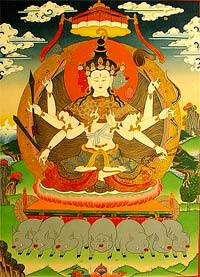 Ushas & Eos are certainly the same goddess, as is Marici or Marichi, called "the Sun of happiness." She is recognized by her modern worshippers as one & the same with "the Woman Clothed in Sun" from Revelations, i.e., the Virgin Mary as Supernal Goddess. Ushas wore orange-red robes & a golden veil (all dyed of saffron), & unveiled herself only to the wise. When a Vedic hymn says that Ushas "tramples transient night," her role as light-bringer is not merely herald to the sun, but of knowledge that banishes ignorance.
Ushas & Eos are certainly the same goddess, as is Marici or Marichi, called "the Sun of happiness." She is recognized by her modern worshippers as one & the same with "the Woman Clothed in Sun" from Revelations, i.e., the Virgin Mary as Supernal Goddess. Ushas wore orange-red robes & a golden veil (all dyed of saffron), & unveiled herself only to the wise. When a Vedic hymn says that Ushas "tramples transient night," her role as light-bringer is not merely herald to the sun, but of knowledge that banishes ignorance.Marici was the Brahmanic, Taoist, & Northern Buddhist personification of the Sun, the Dawn, & the Sun's Rays. She rides across the sky in a chariot drawn by seven white boars, as seen here at the right, boars drawing her throne, weapons in her six arms. Ushus similarly rode a dawn-chariot drawn by seven cows or by seven saffron-winged mares, identical to Eos whose chariot was drawn by winged roans. That Marici often has a warlike demeanor finds her in Japan as Marishiten Queen of Heaven, Goddess of Sun & Moon, Zen patroness of the samurai class. And this warlike character was assumed likewise of the Vedic Dawn-mother Ushus, whose very name can mean "to burn," & who bore the title Leader of Light, from whose wrathful face demons ran to hide.
Marici was known throughout the Near & Mid-East as the Akkadian goddess Mari, which became one of the most common girls' names in the lands of the patriarchs. In some Semitic tongues her name meant "Bitterness," & saffron used too strongly is very bitter, but additionally the bitterness was that of death, which saffron crocuses symbolized. Mari also meant "the sea," for the pinwheel of heaven went in & out of the sea, to & from the underworld. The Romans remembered Marici as the ancestral goddess of the Latins, Pliny noting that she was the mother of Latinus, who might well be regarded as a byform of Mars, the mother of Mars being Juno Februaria, whose Festival of Candles was transferred in the Christian era to the Virgin Mary as Candlemas.
Although Marici's color was that of saffron spice, Mary's was blue & many are the legends that regard Mary among blue flowers, & this in fact includes the Saffron Crocus, which blooms a violet-blue, with only the styles yellow-red-orange. In Roumania Mary's birthday is celebrated as September 8, & one week later is Cross Day, when the autumn crocuses flower. These are called Flowers of the Dead, & festival activities center around gathering nuts & grapes, & drying herbs for winter medicines.
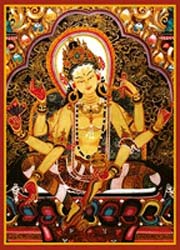 When in The Odyssey we are told "Eos, who had slept beside Lord Tithonos, was rising now to bring light to immortals & to mortals," this is a cultic expression that acknowledges Eos as the wisdom not only of Man, but of Gods, for without Her, the way would never be prepared for the sun, & all would dwell in darkness.
When in The Odyssey we are told "Eos, who had slept beside Lord Tithonos, was rising now to bring light to immortals & to mortals," this is a cultic expression that acknowledges Eos as the wisdom not only of Man, but of Gods, for without Her, the way would never be prepared for the sun, & all would dwell in darkness.So too the Northern Buddhist Yellow Tara is a saffron-robed Wisdom Goddess who lingers in the earthly realm as a Mountain Aesthetic to illuminate the world of man. She is shown six-armed & seated in the illustration at left, with the palms of her hands dyed bright orange-red with saffron.
In India today, the saffron crocus is called Kesar which is grown for divine purposes in the sub-Himalayan region. While today the tradition of the mystic third eye on women's foreheads has largely deteriorated into mere cosmetic affectation, it originated as evidence of annointment & holy devotion, & the dye used was always saffron.
Khamadenu, the Sacred Cow of India, had horns stained with saffron. Her other names are Aditi, Surabhi, Shaval, & Kamduh, the mother of all divinities. The mysterious "Red Heifer" rites of ancient Israel are almost certainly related to a goddess of Khamadenu/Aditi's very type, as worshipped all along the ancient trade routes that once connected Minoan & Indian societies, inclusive of the Lands of the Patriarchs.
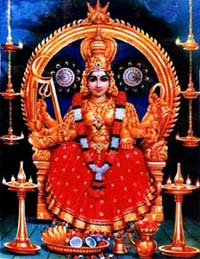 Bhagavati as World-Pervading Saffron-clad Cosmic Energy is a menstruant form of Durga the central Great Goddess of the whole Hindu pantheon. She is nearly always portrayed clad in finery of red, yellow, & gold. Her saffron dyes are associated with her menses, so not only is saffron regarded as a type of blood, just as it was in Greek tragedies, but in this case, saffron menses is the blood that infuses the entirety of the universe, & is the source of all life, a belief held also by certain early Gnostic christians who taught how the menses of Sophia pervaded the material realm giving life to matter.
Bhagavati as World-Pervading Saffron-clad Cosmic Energy is a menstruant form of Durga the central Great Goddess of the whole Hindu pantheon. She is nearly always portrayed clad in finery of red, yellow, & gold. Her saffron dyes are associated with her menses, so not only is saffron regarded as a type of blood, just as it was in Greek tragedies, but in this case, saffron menses is the blood that infuses the entirety of the universe, & is the source of all life, a belief held also by certain early Gnostic christians who taught how the menses of Sophia pervaded the material realm giving life to matter.Saffron Goddess as source of all energy or animating spirit in the material realm is also a feature Tantric buddhism. Saffron invokes the protection of the goddess Kundalini, who dwells in all of us as a serpent-like energy, the source of all Life. Kundalini herself has the form of a serpent, perhaps indeed descended from the very saffron-stained serpent-baring goddess of Minoan Crete.
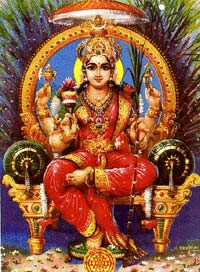 Since saffron dye ranges from golden yellow to deep orange-red, saffron goddesses of India actually combine symbolic elements of the deepest red (demonic & destructive), & the palest yellow (benignant illuminators who bring sacred teachings to mortals). Goddesses of the palest saffron yellow tend to be gentle; of the darkest saffron orange-red violent.
Since saffron dye ranges from golden yellow to deep orange-red, saffron goddesses of India actually combine symbolic elements of the deepest red (demonic & destructive), & the palest yellow (benignant illuminators who bring sacred teachings to mortals). Goddesses of the palest saffron yellow tend to be gentle; of the darkest saffron orange-red violent.Among the gentler goddesses is Saffron Gauri, depicted in the portrait at the left. Her name means "yellow-red," but because of the bright excesses of her shrines & idols, her name fell into English usage as "garish." She is called the Maidenly One & as a grain-goddess receives offerings of saffron-spiced rice. She is actually a disguised aspect of Kali, the energizing consort of Siva. Kali felt that Siva had become upset with Her sinister, warlike character, & had lost interest in her because of the burnt blackness of her visage. Therefore she sloughed her skin as would a serpent, revealing herself to be the pretty Gauri, wonderfully clad in yellow & orange.
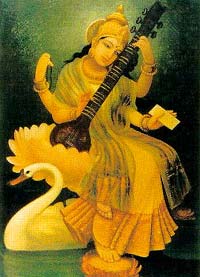 Although Sarasvati, goddess of wisdom & libraries & music, is generally white, she is often white & saffron, & occasionally pure reddish yellow & seated upon or attended by a yellow rather than a white swan, as shown here at the right with her lute.
Although Sarasvati, goddess of wisdom & libraries & music, is generally white, she is often white & saffron, & occasionally pure reddish yellow & seated upon or attended by a yellow rather than a white swan, as shown here at the right with her lute.Sarasvati has this yellow form (as opposed to a bright orange-red) because her fire or energy is inward & reflective, rather than outward-reaching or destructive as is the case with many goddesses who range into deeper oranges & reds.
Sarasvati, like Eos, is an illuminator of humanity, bringing or preserving wisdom in the form of arts & letters. She loves scholars & musicians & scientists rather than warriors. Yet one unfortunate aspect of modern brahmanic Sarasvati worship incudes some far-right extremists who use the archeology & literature to find or even trump up "evidence" that other faiths, & particularly Islam, have no place in India. This is called the "saffronization of history," & Saffronists are the ones who bomb or burn down mosques, then fight to keep mosques from being rebuilt on the "archeological" evidences that Vedic temples were there first.
Saffronizing history means to overlook all evidence that for millenia India has had many co-existing ethnic groups, races, & religions, & focus exclusively on whatever might indicate the eternal preference for Brahmanism, projecting a future in which again only Brahmanistic faith endures. I think Sarasvati would be mightily disappointed in these madly intolerant devotees' exchanging learned wisdom for folly & violence, but there certainly are darker saffron goddesses who could well support them.
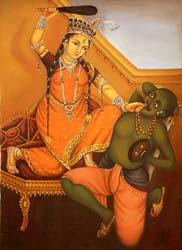 At the other extreme from gentle yellow, the cruelest of the saffron goddesses is Bagala or Bagalamukhi who is the deepest red-orange, hence more inclined to violence. She is shown in the next illustration (on the left) with yellow complexion & saffron robes, with upraised cudgel, grasping the tongue of a demon. She silenced her enemies by ripping out their tongues or otherwise rendering them mute, but she blessed those with whom she sided with strong speech, & shares much in common with Vac, the Vedic goddess of speech. Though like Kali she can be beautiful, loving, & protective, her central nature is violent, death-dealing, & disease-causing, for she is Queen of Witchcraft or Black Magic.
At the other extreme from gentle yellow, the cruelest of the saffron goddesses is Bagala or Bagalamukhi who is the deepest red-orange, hence more inclined to violence. She is shown in the next illustration (on the left) with yellow complexion & saffron robes, with upraised cudgel, grasping the tongue of a demon. She silenced her enemies by ripping out their tongues or otherwise rendering them mute, but she blessed those with whom she sided with strong speech, & shares much in common with Vac, the Vedic goddess of speech. Though like Kali she can be beautiful, loving, & protective, her central nature is violent, death-dealing, & disease-causing, for she is Queen of Witchcraft or Black Magic.The association of saffron with witchcraft & disease was not an Indic imposition, as the sorcery goddess Medea used saffron to make Jason fall in love with her. The saffron of Eos was regarded as an aphrodisiac of such power no man could resist its effect. It was the source even of the virility of Priapos. The budding crocus & its long tube in fact resembled the Mother's serpents, & until opening were regarded as phalluses, then closed again each night to again resemble phalluses or serpents' heads issuing from underground. Eos herself was as a rule sexually out of control because of her saffron nature, without which she would neither have loved nor illuminated mortals.
That saffron was always believed to have healing properties was a two-edged bargain that did not define saffron only as good. Any Goddess that healed sickness did so because she had rule over sickness. In modern India it is always the Pox-mother who causes as well as prevents disease, & her red mouth may consist of blood or saffron, as her bright red palms can be henna or saffron or from dipping her hands into the blood of the slain.
So too in the ancient Near East the Mother Goddess was simultaneously the cause of Life, & the cause of all Death, as Saffron in small doses was regarded as an aphrodisiac facilitating procreation, but in high doses was used by women to induce abortions, or can have harmful allergenic properties.
The Goddess Anath was said to be redolent of spice, & to have dyed her hands red with henna or saffron. She was a warlike huntress, & a loving fertility goddess, so like Mother Kali, the semitic Anath, called the bride of Yahweh at Bethel, might on alternative days smell of death & blood, or of a spicy red dye that aroused desire. Another semitic goddess, a reflex of Anath called Paghat (from whom obviously I adapted my own nom de plume), seems to bare a name which refers to her spicy redolence, & like Anath she is both loving & warlike, having waged battle against one of the henchmen of Asherah in order to avenge her brother.
While one aspect of this ancient All Mother was reduced to Earthmother only, with such names as Rhea, Gaea, Ge, or Ki, that aspect which rises from darkness into Olympus became the Dawn-goddess Eos or Ushas. By the name Cybele, however, we find many elements of the original All Mother still fully intact, as in the myth of her war against her own son, Zeus.
When Zeus at last said he would permit Her to retain half the rule of the sky & half the rule of the Earth, she said no thanks, as she would rather have full rule of the Earth than rule half of anything. In this myth is a cultic assumption favoring Cybele (Rhea) as the complete & unutterable ruler of the world, inclusive of the underworld, & indeed no myth assumes Zeus could ever command either Cybele or her dark form Hecate, whom Hesiod knew as an All-mother rather than only a queen of darkness. But certainly the element of a Queen of Darkness was always part & parcel with the All-seeing Sun-mother who withdrew to the underworld by night & was ruler of shades, her nature dwindling in time to witchcraft goddesses of the underworld, & dawn goddesses who rose out of the sea or the underworld to illuminate the world.
Continue to:
Part III:
Crocus as Cretan All-mother Kar